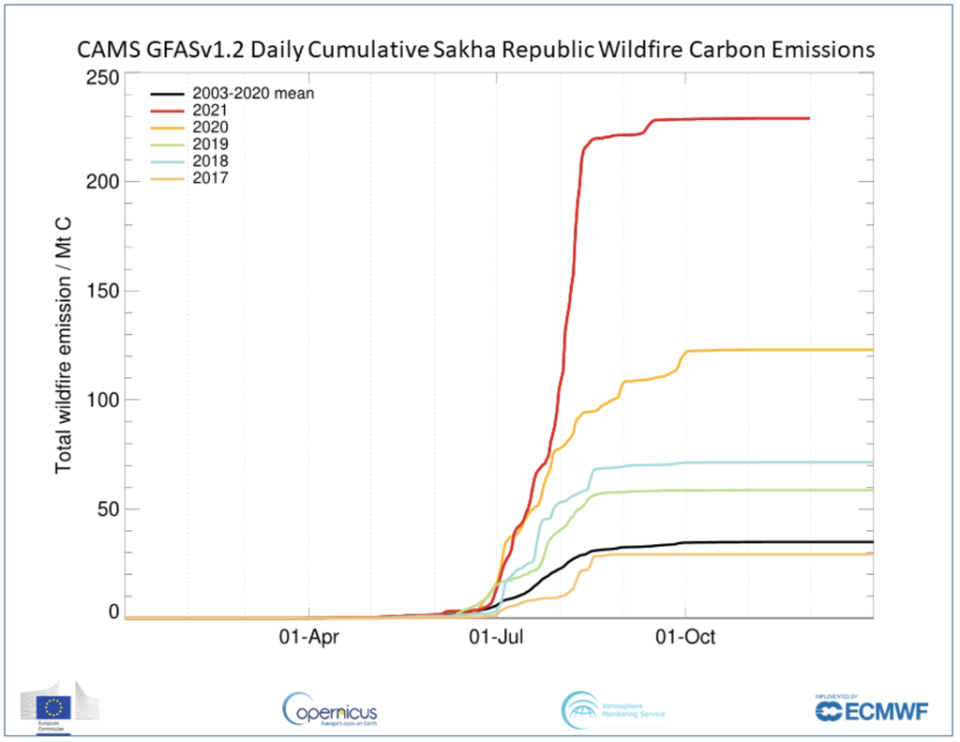Real-time satellite observations reveal how wildfires devastated the planet in 2021
The spread of extreme and sustained wildfires across vast areas of the planet in 2021 has been captured by real-time satellite observations.
Wildfires caused an estimated total of 1,760 megatonnes (Mt) of carbon emissions to be pumped into the atmosphere this year - equating to nearly a third of total US annual emissions.
The observations of active fires were captured by the Copernicus Atmosphere Monitoring Service (CAMS), allowing wildfire emissions to be estimated in near real-time, along with the impact on air quality.
Extreme heat and drought conditions driven by the climate crisis are fueling larger and more unpredictable wildfires.
The summer of 2021 was particularly dire with fires erupting across large areas of North America, Siberia, eastern and central Mediterranean, and North Africa.
August’s total estimated emissions were the highest of the year, with an estimated 378Mt of carbon released into the atmosphere globally. More than half of the emissions came from fires in North America and Siberia, two of the worst affected regions.
Wildfires in the Sakha Republic, northeastern Siberia, set the highest summer-time total from June to August, and was more than double previous years, according to the CAMS 19-year, Global Fire Assimilation System (GFAS) dataset.

Following an unprecedented level of blazes in 2020, this summer saw wildfires explode across western parts of North America.
The Canadian province of British Columbia was badly impacted following a deadly heatwave in the region at the beginning of summer. A fire on 30 June wiped out the small town of Lytton, BC, and caused two deaths.
In July, California recorded its largest fire in state history, the Dixie Fire. It’s also believed to be the first to crest the Sierra Nevada mountain range.
The high intensity and persistence of US wildfire emissions was captured in satellite observations as a large plume of smoke, which crossed the Atlantic Ocean before mixing with wildfire smoke from Siberia, and drifting to the UK and across Europe.
In eastern and central Mediterranean countries, there were several days of extreme wildfires in July and August, leading to high concentrations of fine particulate matter (known as PM2.5) and degraded air quality.
This summer saw extreme drought and high temperatures in parts of Europe, creating a perfect storm of conditions for severe blazes.
Turkey was devastated by wildfires in July and severe impacts were also felt in Greece, Italy, Albania, North Macedonia, Spain, Algeria and Tunisia.
In late September, the annual seasonal crop stubble burning begins in Pakistan and north-western India. CAMS reported that the haze and smoke pollution led to very high concentrations of air pollution including PM2.5, impacting millions of people. Wildfires were most severe in the Indian states of Punjab and Haryana.
“As the year draws to a close, we have seen extensive regions experience intense and prolonged wildfire activity, some of which has been at a level not observed in the last couple of decades, said Mark Parrington, senior scientist and wildfire expert at the ECMWF Copernicus Atmosphere Monitoring Service.
“Drier and hotter regional conditions caused by global warming increase the risk of flammability and fire risk of vegetation and this has been reflected in the extremely large, fast-developing and persistent fires we have been monitoring.”
Read More
Children on the front line of the climate crisis
Thanksgiving cancelled in parts of California after power shut-offs over fire risk
Extinction of megafauna such as mammoths ‘triggered global rise in wildfires’
Prince of Wales hosts hedgelaying event at Highgrove estate
The climate crisis could be driving the hybrid salmon population
California is largest consumer of oil being drilled in the Amazon

 money
money 